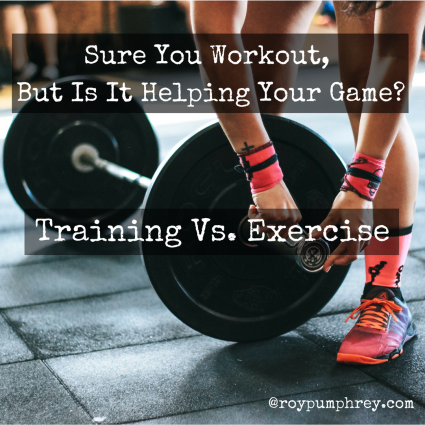
Training is Exercise With Performance Outcomes in Mind….
Working out is Exercise With Health Outcomes in Mind….
From a distance they look the same, but there is actually a world of difference.
Here’s the truth:
95% of people WORK OUT.
And that’s ok, hell, its probably preferable.
It’s a good thing to be in good health, and “fit” and feel good about yourself, able to walk up stairs without the need for a timeout, straight O2, or a good jolt from an AED.
But it’s not the end goal of TRAINING. <—-hopefully its a nice fringe benefit
Training is exercise that is FOR something, an event, sport, activity.
Don’t be fooled by frequency, volume, intensity or complexity.
Ex. Crossfit
This isn’t so much the case anymore but at the height of the CrossFitting about 4-5 years ago the measure of a workout and to an extent a “box” was how often they went all out, balls to the wall, gas pedal down.
Remember when Greg Glassman and the Crossfit disciples used to pull the,
“Just wait until some of the best athletes in the world adopt CrossFit. They’ll set world records”
Well, that time came and went, and no new records.
Why?
Cause CrossFit, like it or not, is just too much general work and misdirected high intensity to help a higher level athlete achieve greater results.
YES, for the dude on the street, you can improve your health.
Hell, LOTS of people get in really good shape X-fitting.
But they’re not setting world records.
In fact, as people who started in CrossFit got introduced to things like Olympic and Powerlifting and started to become somewhat successful, they left CrossFit.
Precisely because its lots of EXERCISE, not a lot of TRAINING.
They needed more directed, planned, and managed training towards specific goals, ie physiological outcomes to continue improvement.
And no, I don’t think TRAINING has to be a sporting event.
For Example:
“Hey, I’m going to the beach in 6 weeks and need “this” fixed”
“This” usually refers to the resultant of excess amounts of:
- Pizza
- Wine
- Cheese
- Beer
- Cheese Burgers
- Tacos
- Cookies
- Turkey Hill Ice Cream <–cause there is no other.
So instead of fitting the workouts to support general life stuff.
We may ramp up the conditioning, try to focus on certain body parts, whatever it is.
Change the focus, ramp up intensity, frequency, duration……whatever.
But there is a general end goal with a timeframe attached.
Whereas for most people it’s usually just:
“I don’t want to die from being a lazy sack O’ shit at 65”. <—see what I mean, its pretty broad, and you can kinda throw whatever you want at it and it’s gonna push the ball downfield.
And I’m totally cool with this.
I know, you get that internet bullshit, “You gotta have something to train for all the time” and all that.
And that DOES work for short-term things and events, but for the AVERAGE person, in real life, it’s just not sustainable.
Sometimes, as life accumulates, you gotta pull back and have periods of cruise control.
You can’t put that kind of effort and focus on training for something 24/7, 365.
Sport Performance:
Training for a sport is only about performance.
Usually it’s also entails injury prevention, cause if you’re injured you can’t play and that’s performance..
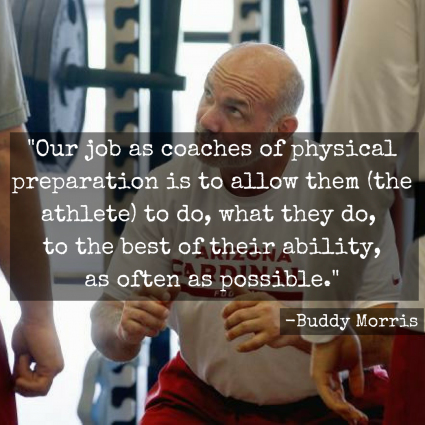
Training may entail more “specific” movements, heavier or more volumous periods, times of greater risk, times of lesser volume, and times of lesser risk than just working out would. <—-sound like periodization?
At the ground level, the major difference between Training and Working Out is: Exercise Selection.
There Are No Magic Exercises!
But
Exercise Selection Counts.
Just “doing stuff” probably wont do sh@t for your game unless:
A) You suck
B) You’re in terrible shape.
Either way almost anything would work.
“Athletes that are at a lower level of sports mastery may benefit from nearly any training modality and in turn could see positive transfer of training to commonly executed sport tasks”- NSCA
In those cases just “doing stuff” or, working out, any exercise, will have a positive effect.
But what if I Don’t Suck?
Than you’re going to need a less generalized approach.
At least some of the time.
Not necessarily,“Sport Specific” exercises because, well, they don’t really exist.
At least not in the way you think.<–tangent starts here
But My Kid Goes to This Place and Does Lots of “Sport Specific” Stuff?
That might be true, if they’re doing things like:
- Sprinting
- Jumping
- Throwing
- Actual movements at the actual speed of competition, etc,
Other than that, ain’t no exercise in the gym they’re doing “Sport Specific”..
It’s probably closer to a circus act and worthless, than it is closer to helping them at their sport.
Before I get to far out in front of myself, here’s the definition of “Sport Specific” exercise from Kelly Bagget:
“Let’s start off with a definition of sport-specific. A truly sport specific exercise must:
A: Duplicate the exact movement witnessed in certain actions of the sports skill
B: The exercise must involve the same type of muscular contraction used in the skill execution.
C: Develop strength and flexibility in the same range of motion (ROM) as the actual skill.”
For an exercise to be classified as truly sport specific it must replicate the forces and joint-angle velocities seen in the sport.
Now really think about those “sport specific” exercises.
What they’re doing doesn’t really match the criteria does it?
Yeah, sorry bout that.
This is NOT to say that general strength cant and doesn’t transfer.<—-tangent done.
“transfer will take place much easier in lower level athletes due to their high sensitivity levels to physical activity. Their room for adaptation is much larger than their more advanced counterparts. At those low levels, general strength training exercises will simply carryover more easily to in-sport performance“- NSCA
Lets Say You Don’t Suck:
This is where your exercise selection and EXECUTION matters.
Simply “doing stuff” might help with your physical fitness but not have much of an effect on your game.
Hell, it could actually be a negative effect.
“It has been shown that athletes whom are at beginning or lower levels, can simultaneously develop increases in several independent physical characteristics such as strength, power, speed, and hypertrophy. whereas those athletes who already possess higher levels of strength and/or training status may no longer achieve the desired training adaptation through the greater attainment of that physical quality“ – NSCA
Case in Point:
Riding the F-Ing Bike..
Bike riding is fine, this is NOT a diatribe about bike riding.
But if I hear one more person tell me they train for their sport (unless its bike riding) by “riding the bike” I’m going to go to the nearest Soul Cycle and take away they’re $10 a bottle lavender infused Vitamin water. <—I made that up.
Lets Start With the Good:
Riding the bike can:
- Build some aerobic endurance
- Build anaerobic endurance
- Some quad strength/ endurance (maybe)
- Take some of the “pounding” off of an athlete
If it’s on a road or mountain biking you can add in some upper body and core strength and add back in some of the pounding.
All those things are good and could help with your physical fitness, your base.
And if your base needs work?
Riding the bike will help.
Truth is:
You NEED base. Its VERY important.
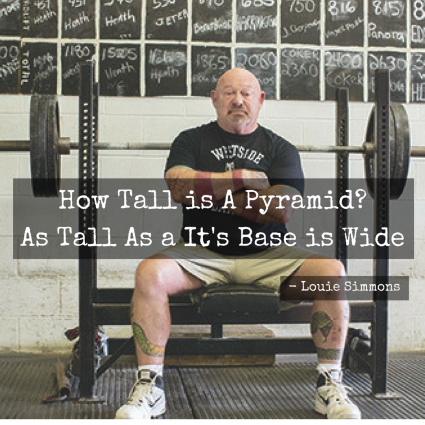
The base work builds the foundation (physical fitness) for all of the more specific (yet still generalized) work that will be built upon it.
My Gripe With the Bike:
In EVERY field sport the HIP is the driver of motion. <—-this is why field sport athletes have good butts.
In cycling, the hip does about as little as it can get away with.
Literally, mechanically, cycling changes the primary force producing joint from the hip to the knee.
Wait But What?
Its Called a Crank.
If you try to perform any ANY field sport I can think of with an ankle/knee -flexion/extension strategy instead of a HIP/ knee- flexion/ extension strategy
You’ll SUCK…
Two major actions can be discriminated in running: a stance action and an alternating hip flexion–extension
action. – Gazendam and Hof
Based off the criteria for “Sport Specific”
Similar Force and Joint Angle Velocities…..
The bike doesn’t come close:
“Your glutes are the large-and-in-charge sitting muscles, which do the job of extending your hips and producing about 27 percent of your pedaling power…..Your quadriceps, the muscles that run down the front of your legs from your hips to your knees, are your knee extensors. They produce about 39 percent of your pedaling power…..As the muscles that flex your knee, your hamstrings help sweep the pedal back to the 9-o’clock position and contribute about 10 percent of the power needed to turn the crank. Your calves, which include the large gastrocnemius muscle just below the back of the knee and the soleus further down, act as stabilizers throughout the pedal stroke and help produce about 20 percent of the power load“…Bicycling.com
When sprinting…
“muscles mainly responsible for forward propulsion in full speed sprinting are the hamstrings, the glutaeus maximus and the adductor longus. The hamstrings are singled out as the most important contributors to produce highest speed levels.” -Wiemann and Tidow
The bike literally uses the EXACT OPPOSITE STRATEGY of propulsion.
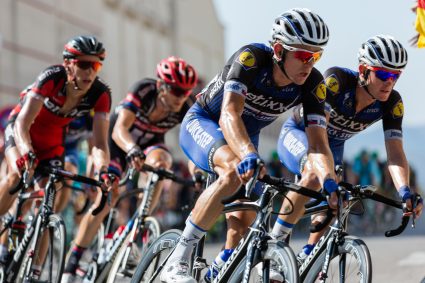
Primarily relying on the quads and calves while sprinting relies on the hamstrings and glutes.
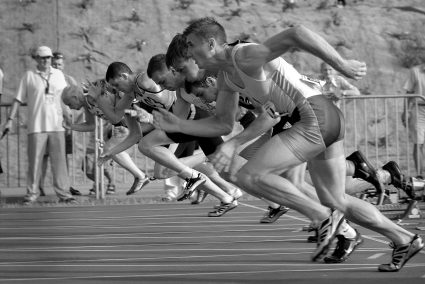
But Lindsay Vonn Rides the Bike:
*I train a bunch of skiers and Instagram is a blessing and a bitch. Click and follow me 🙂
Yes, she does.
But is it in the OFF SEASON, to build aerobic and anaerobic capacity?
To build the BASE qualities….
Does she also do a Metric Sh@t Ton of other work?
Some of it very general, some of it more specialized.
The answer is probably a big fat:
YES
It’s all pieces of the puzzle.
There is NO SINGLE PIECE
How the Pieces Fit:
A: Riding the bike builds aerobic and anaerobic capacity.
B: Aerobic capacity allows for recovery and training base. ie more work can be done in a single bout and you’ll recovery from it sooner.
C: Because a larger volume of both general and specific work can be done the physical qualities of the athlete are heightened.
D: With heightened physical qualitites the athlete can:
- Create and absorb more force
- Is more resilient to injury
- More successfully attain and demonstrate sport postures/ movements under greater loads more often.
(A) didn’t equal (D)
But (A) did facilitate the growth of (D).
This quote describes strength, but applies to all “base” qualities:
“To improve athletic performance, general strength exercises should be used in the initial stages to build a base. The goal of these movements is to stimulate and strengthen the same muscles involved in the sports skill. Once a strength base is in place, exercises that are truly specialized (sport-specific) can be incorporated to zero in on targeted weaknesses involved in the sports skill or to help enhance the transformation of general strength into specific strength. In this way, maximal strength is developed initially and then used to enhance explosive strength that can be incorporated into the sport action.” – Kelly Baggett
And that kids is why riding the bike as your PRIMARY form of training for virtually ANY sport other than cycling is total BULLS@T.
Again, its not “bad” for your health, as your workout, or even as part of a sports training regimen.
Keep in mind, this has nothing to do with how often or intensely you ride.
But if riding the bike is all you’re doing to train for your sport…Ain’t Gonna Cut it.
“I Have a Really Strong Low Back and Core”
That’s what a recent eval told me.
And she did.
But that was kinda the problem.
Measures of health?
She looked to be a rockstar in many respects.
Exercised often and by all accounts lives a pretty righteous life.
But, again, we play a sport and would like some of this “working out” to transfer.
The sport?
Golf.
*I train a bunch of golfers too.
Remember that really strong low back and core?
Yeah, they were strong but the issue was how and why they got that way.
Lots of exercises like hyperextensions, Russian twists and other exercises performed in a manner where the lumbar/ core region was creating motion instead of resisting motion.
The issue with that?
The lumbar region is the last place you want to teach the body to move.
Golf, like all rotational sports, relies on rotation from the thoracic spine and the hips to effectively generate a forceful, reproducible and safe swing.
“Having established where the rotation should be coming from, we can propose that there are plenty of golfers out there who are generating their backswing ‘turn’ through other compensatory movements! They will gain rotation through the lumbo-pelvic region by making these compensatory movements (e.g. changes in leg movements, buckling knees inwards or straightening the knee-joint to provide any sort of added rotation through the hip and generally excessive resultant pelvis turn), but this may come at a cost: reduced clubhead speed (lack of separation between upper and lower body) and increased risk of injury to the back, hip, knees or other areas of the body, especially when combined with overuse of these movements.
As rotation is so important, how do we go about ensuring it comes from the right places?
The key is to make sure that clubhead speed in the swing is not limited by physical constraints, and in this case, a lack of range of movement in T-Spine. The strength and conditioning focus, therefore, needs to be on improving both T-spine AND hip rotation (both internal and external).” – TPI
So wait, we need to be “Super Stiff” through the core (like always) and rotate above and below it?
Why Are We Doing Exercises That Train Movement Through the Lumbar?
I have no idea.
But I do know, that doing so teaches the body to create motion there, ingraining that motor pattern and transferring it (at least in part) to other motions.
ie. a golf swing.
Truth is, you may not move through the lumbar at all when you’re fresh and focused and things are easy.
But a few holes later, as fatigue sets in or when you really try to load up and bomb a drive….
You’re going to default to the positions, postures and movement strategies that the body has used to navigate stressful situations successfully.
In this case that means moving instead of stiffening through the lumbar.
Increasing the chance of a bad swing.
Decreasing the power transferred into the ball.
Increasing the chance of injury.
None of what we want.
Looks like training all of that motion in the core might not have been the best idea, at least not in its transference to golf, huh?
Take Home:
We live in a world where people don’t exercise nearly enough.
So I’m not telling you what you’re doing is worthless.
Actually, it’s the opposite.
Any exercise that’s improving your health is worthwhile.
But that doesn’t mean it’s helping your sport.
“Exercise is physical activity for its own sake, a workout done for the effect it produces today, during the workout or right after you’re through. Training is physical activity done with a longer-term goal in mind, the constituent workouts of which are specifically designed to produce that goal. If a program of physical activity is not designed to get you stronger or faster or better conditioned by producing a specific stress to which a specific desirable adaptation can occur, you don’t get to call it training. It is just exercise. For most people, exercise is perfectly adequate – it’s certainly better than sitting on your ass.“ –Mark Rippetoe
Just “doing stuff” usually isn’t good enough to improve your game.
The “stuff” you do needs to facilitate the ability for you to improve your sporting form.
There has to be Transference.
But there MUST be a BASE of physical fitness qualities to build on:
“in an attempt to accelerate the progress of the athletes, many sports performance professionals will implement dynamic correspondence too early in the progression of an athlete’s mastery. Even though that statement may seem counterintuitive based on the comments made earlier in this article, an attempt to have athletes perform exercises of SPP (special/ sport specific)-nature before they are fully ready will only inhibit the long-term athlete development of the given individual.
The reason for this is he/she may not have attained sufficient levels of general physical qualities (such as strength or flexibility), optimized sporting skill technique, or perfected appropriate neuromuscular programs prior to performing exercise of SPP-nature.” – NSCA
Otherwise, your training is just exercise and your exercise can never be training.
Always remember:


